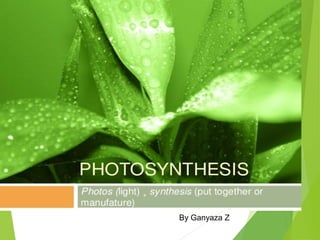
Presentation photosynthesis
- 1. By Ganyaza Z
- 2. Review What is photosynthesis? Process by which energy from sunlight is used to convert water and carbon dioxide into highenergy carbohydrates (sugars and starches) and oxygen as a waste product Who uses photosynthesis? Plants and other producers
- 4. Jan van Helmont 1643 Belgian physician Do plants grow by taking material out of the soil? Mass of soil Mass of seed Watered regularly @ end of 5 yrs, tree was 75 g, soil the same Conclusion: Mass came from water Accounts to the “hydrate” portion of carbohydrate produced but what made the “carbo-” portion
- 5. Joseph Priestly 1771 English minister Bell jar, candle, plant Jar over candle flame died out Jar over candle with live sprig of mint flame didn’t die Conclusion: Plant releases oxygen
- 6. Jan Ingenhousz 1779 Dutch scientist Aquatic plants produce bubbles only when light is present Conclusion: Plants need sunlight to produce oxygen
- 7. Julius Robert Mayer 1845 German scientist Proposed that plants convert light into energy into chemical energy
- 8. The experiments performed by van Helmont, Priestly, and Ingenhousz led to work by other scientists who finally discovered that in the presence of light, plants transform carbon dioxide and water into carbohydrates, and they also release oxygen Hill, R. (May 1999). "Oxygen Produced by Isolated Chloroplasts". Proceedings of the Royal Society of London. Series B, Biological Sciences 127 (847): 192–210
- 9. Review Sunlight White light ROYGBIV Combo of all colors Pigments Chemicals that absorb electromagnetic radiation (visible light) Light absorbing molecules Electromagnetic spectrum Electrons=energy
- 11. Chloroplast (found in cells in leaves) Concentrated in the cells of the mesophyll (inner layer of tissue) in leaf Stomata Tiny pores on surface of leaf Allows carbon dioxide and oxygen in and out of the leaf Veins Carry water and nutrients from roots to leaves Deliver organic molecules produced in leaves to other parts of the plant
- 12. Chloroplast Cellular organelle where photosynthesis takes place Double membrane Outer membrane Stroma (fluid filled space) Inner membrane Thylakoids Granum Intermembrane space Contain chemical compound called Chlorophyll This molecule gives chloroplast its green color
- 13. Structure of Chloroplast Structures organize the many reactions that take place in photosynthesis Stroma Thick fluid enclosed by the inner membrane Thylakoids Disc-like sacs suspended in the stroma Has membrane that surrounds inner thylakoid space Grana (sing. Granum) Stacks of thylakoids
- 16. Chlorophyll Plants principle pigment 2 types Chlorophyll a Absorbs light in the blue-violet and red regions of visible spectrum Chlorophyll b Absorbs light in the blue and red regions of the visible spectrum Chlorophyll does NOT absorb light well in the green portion of the visible spectrum Green light reflected by leaves This is why plants look green…they reflect green light Carotene Secondary plant pigment Red and orange pigments Absorb light in other regions of the spectrum other than red and orange
- 17. 2 main stages Light Dependent Rxn Light-Independent or Calvin Cycle
- 18. Photosynthesis Overview #1 “Light-Dependent” reactions Convert the E in sunlight to chemical energy Rxns depend on molecules made in membranes of thylakoids Chlorophyll in membr. captures light E Chloroplast use E to remove e- from water Splits water into oxygen (waste) and hydrgen ions e- taken are used to make high-E molecule NADPH (similar to NADH) Chloroplast also use captured E to make ATP Overall Product: convert light E into chemical energy stored in compounds ATP and NADPH
- 19. Photosynthesis Overview # 2 “Light- Independent” Reactions aka The Calvin Cycle Makes sugar from atoms of CO2 and H+ ions and High-E e- carried by NADPH Enzymes for these reactions are dissolved in the stroma (outside thylakoid) ATP made by light Rxns provides E to make sugar (glucose) Called light independent, b/c unlike unlike the light reactions, these do NOT require light tp begin However, this cycle does require two things made by the light reactions: ATP and NADPH This means that the calvin cycle cannot necessarily continue in the dark
- 20. List of references ^ "photosynthesis". Online Etymology Dictionary. (http://bioenergy.asu.edu/photosyn/study.html).
- 21. REFERENCES Bryant DA, Frigaard NU (November 2006). "Prokaryotic photosynthesis and phototrophy illuminated". Trends Microbiol. 14 (11): 488–96] Buick R (August 2008). "When did oxygenic photosynthesis evolve?". Philos. Trans. R. Soc. Lond., B, Biol. Sci. 363 Olson JM (May 2006). "Photosynthesis in the Archean era". Photosyn. Res. 88 (2): 109–17. Online Sources http://bioenergy.asu.edu/photosyn/stuy.html http://hdgc.epp.cmu.edu/teachersguide/teachersguide.htm
